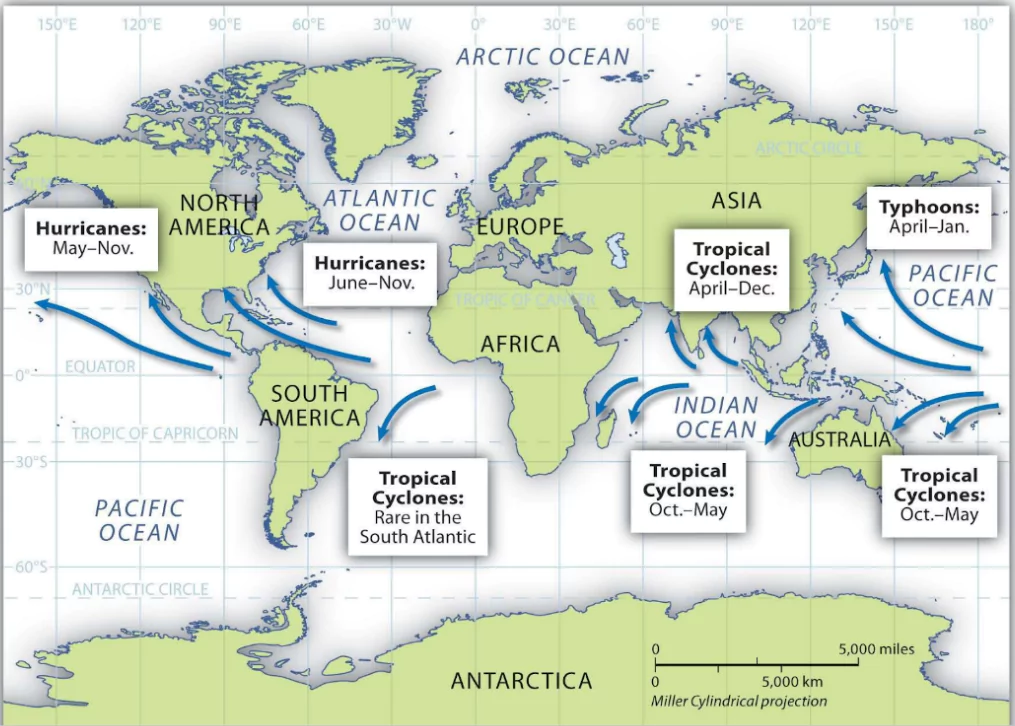Recently, Odisha has started preparing for a possible impact from Cyclone Dana in the coastal areas.
- The cyclone will be called “Dana” (a beautiful, precious pearl in Arabic), a name given by Qatar.
- Cyclone Dana is expected to make a landfall over the coastal states of West Bengal and Odisha
About Cyclones and Circulation Patterns
- A cyclone is a large-scale air mass rotating around a strong centre of low atmospheric pressure.
- These can be classified on the basis of their origin into tropical and extratropical cyclones.
- The wind around a low-pressure system in a cyclone is called cyclonic circulation, while around a high-pressure system, it’s called anticyclonic circulation.
- Types of Cyclones: Cyclones fall into two main categories
- Tropical Cyclones: form between the Tropics of Capricorn and Cancer, developing over tropical or subtropical waters, where they organize into surface wind circulation patterns.
- Extra-tropical cyclones (Temprate cyclones): typically occur in temperate and high-latitude regions, originating even from the Polar Regions.
- The table given below shows Pressure Systems and Wind Circulation Patterns.
Enroll now for UPSC Online Course
| Pressure System |
Pressure Condition at the Centre |
Pattern of Wind Direction
|
| Northern Hemisphere |
Southern Hemisphere |
| Cyclone |
Low |
Anticlockwise |
Clockwise |
| Anticyclone |
High |
Clockwise |
Anticlockwise |
About Tropical Cyclone
- They are confined to the area lying between 30° N and 30° S latitudes in the atmosphere.
- Cyclones in India: Tropical cyclones in the North Indian Ocean region develop during the pre-monsoon (April to June) and post-monsoon (October to December) periods.
- Required condition for a Cyclone:
-
- Sea surface with high temperature (above 27^0).
- Presence of coriolis effect for the creation of a cyclonic vortex.
- Small variations in the vertical wind speed.
- Latent heat for driving storm’s energy
- Upper level divergence above the Sea Level System.
Characteristics of Tropical Cyclone
- It is a Violent Storms originate over oceans in tropical areas.
- Eye of a Tropical Cyclone: Eye has the lowest surface pressure and warmest temperatures and air descends at the centre.
- At the centre: Roughly circular calm area of comparatively light winds and fair weather
- Temperature: Only 0-2°C warmer at the surface in the tropical cyclone
- Driving Force: Latent Heat of Evaporation released by the condensation of moist rising air over oceans is the driving engine
- Path: They move in a parabolic path towards the west under the influence of trade winds.
Cyclone Naming Protocol
- Rotational Basis: Cyclone names are assigned on a rotational basis by countries in a pre-determined list.
- Regional Meteorological Centers: Worldwide, Six specialized regional meteorological centers (RSMCs) and five regional Tropical Cyclone Warning Centres (TCWCs) are mandated for issuing advisories and naming tropical cyclones.
- IMD’s Role: Indian Meteorological Department (IMD) is one of the RSMCs providing advisories and naming for the north Indian Ocean Including the Bay of Bengal and the Arabian Sea.
 Member Countries: IMD serves 13 member countries under the WMO/Economic and Social Commission for Asia-Pacific (ESCAP) Panel.
Member Countries: IMD serves 13 member countries under the WMO/Economic and Social Commission for Asia-Pacific (ESCAP) Panel.-
- These are Bangladesh, India, Iran, Maldives, Myanmar, Oman, Pakistan, Qatar, Saudi Arabia, Sri Lanka, Thailand, United Arab Emirates, and Yemen.
- Current list has a total of 169 names including 13 names each from 13 WMO/ESCAP member countries.
Check Out UPSC CSE Books From PW Store
Worldwide Terminology of Tropical Cyclones
- Typhoons: China Sea & Pacific Ocean;
- Hurricanes: West Indian islands in the Caribbean Sea & Atlantic Ocean;
- Tornados: Guinea lands of West Africa and southern USA;
- Willy-willies: North-western Australia
![]() 21 Oct 2024
21 Oct 2024
 Member Countries: IMD serves 13 member countries under the WMO/Economic and Social Commission for Asia-Pacific (ESCAP) Panel.
Member Countries: IMD serves 13 member countries under the WMO/Economic and Social Commission for Asia-Pacific (ESCAP) Panel.